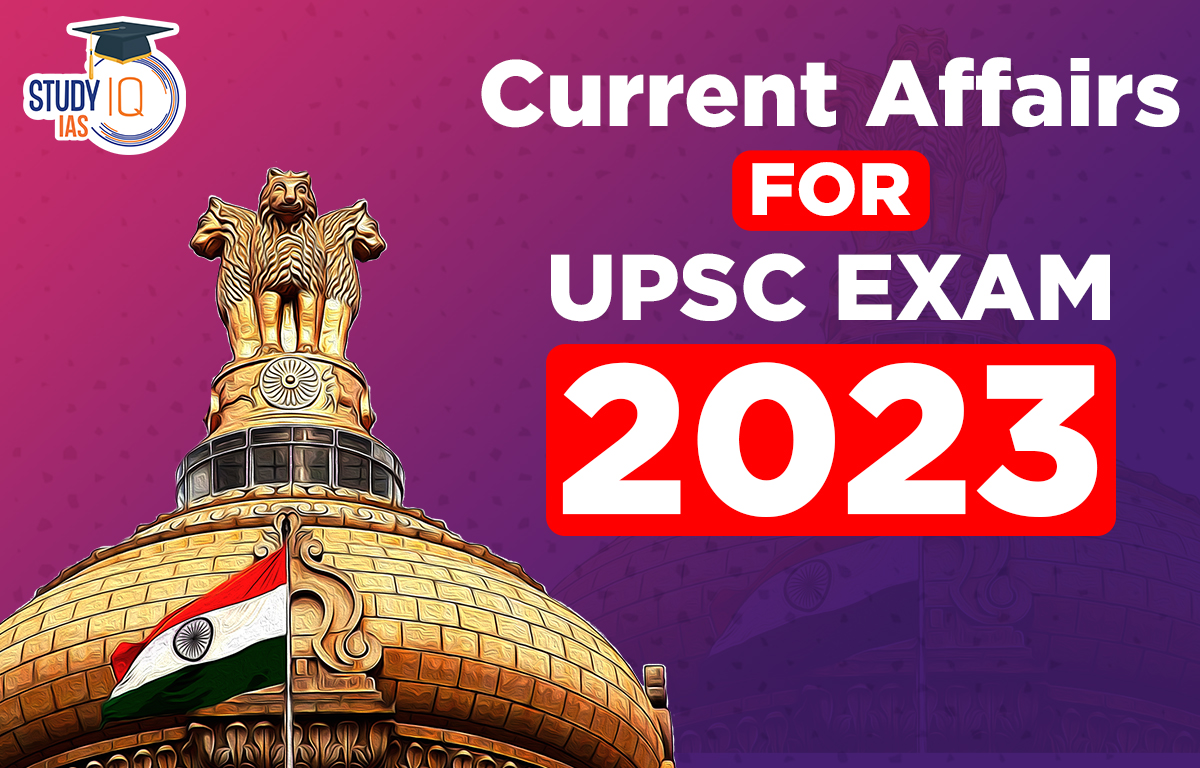Current Affairs 20th April 2023 for UPSC Prelims Exam
Maritime Electric Propulsion Systems
Context: India and the United Kingdom are having discussions over sharing technical experience on maritime electric propulsion systems to meet future requirements of Indian warships.

About Maritime Electric Propulsion Systems
- In conventional power system arrangements, the ship’s propellers are driven by a diesel propulsion engine while the supply of electricity for the other shipboard loads is transmitted via the shipboard generators.
- On the other hand, Electric propulsion systems
- utilize electrical power to drive propeller blades for propulsion.
- Introduction of electric propulsion systems for use in ships offers the following four advantages:
- Simplification of the propulsion system, including the complicated reduction gear used to run the ship (frequent shifts between forward and backward movement)
- In the case of ships that consume extremely large amounts of power, a reduction in the financial burden of maintenance and repair, due to the integration of propulsion motors with power generation motors for use in supporting general internal electrical load
- Silencing of onboard noise
- Improved fuel efficiency during travel due to the ability to constantly maintain a rotational speed that offers good fuel efficiency in the motors used for producing propulsive electric power.

Current Affairs 19th April 2023 for UPSC Prelims Exam
Public Safety Act (PSA)
Context: The Jammu and Kashmir High Court has quashed the detention of journalist under the Public Safety Act (PSA).
Public Safety Act
- The Law: The law was introduced in 1978. It is a preventive detention law that allows the State government to detain a person above the age of 16 up to two years without a trial.
- It was brought in to prevent timber smuggling, and keep the smugglers in prison.
- It is similar to the National Security Act, but this was enacted two years before the NSA came into being.
- Applicability: The PSA allows for administrative detention for up to two years “in the case of persons acting in any manner prejudicial to the security of the State”, and for administrative detention up to one year where “any person is acting in any manner prejudicial to the maintenance of public order”.
- Within four weeks of passing the detention order, the government has to refer the case to an Advisory Board.
- This Advisory Board will have to give its recommendations within eight weeks of the order.
- If the Board thinks that there is cause for preventive detention, the government can hold the person up to two years.
- Enforcement: Detention orders under PSA can be issued by Divisional Commissioners or District Magistrates.
- Problematic Provisions:
- PSA allows the State to hold a person without producing them in court.
- When a person is arrested under the PSA, they do not have legal rights before the Advisory Board to prove that their detention is illegal.
- According to Section 13(2), the detaining authority need not even inform the detained individual as to the reason for the action.
- Section 22 of the Act provides protection for any action taken “in good faith” under the Act.
- Under Section 23 of the Act, the government is empowered to “make such Rules consistent with the provisions of this Act.
- Misuse: Right from the beginning, the law was misused widely, and was repeatedly employed against political opponents by consecutive governments until 1990.
Parambikulam Tiger Reserve
Context: Kerala High Court has ordered to capture, radio-collar, and relocate an elephant to the Parambikulam Tiger Reserve.
About Parambikulam Tiger Reserve
- Location: It is a protected area located in the Palakkad district of Kerala.
- It is one of the biodiversity hotspots of the Western Ghats and is known for its tropical and subtropical moist broadleaf forests.
- Flora and Fauna: The reserve is home to a diverse range of flora and fauna, including Bengal tigers, Indian elephants, sloth bears, Indian gaur, and several species of primates.
- Teak, neem, sandalwood and rosewood are some of the main species found here.
- Geographical features: The Anamalai Hills and Nelliampathy Hills are prominent ranges within the reserve.
- The highest peak in the reserve is Karimala Gopuram, which stands at an altitude of 1,443 meters.
- Hydrology: The reserve features several perennial rivers, including the Parambikulam, Sholayar, and Thekkady Rivers.
- The reserve is home to several wetlands, including the Thoonakkadavu and Nedukkayam wetlands, which provide a habitat for a wide variety of water birds.
- Indigenous communities: Kadar, Malasar, Muduvar and Mala Malasar are indigenous tribes residing in the vicinity.
Indian Nutrition Rating (INR)
Context: The social media influencer drawn into the Cadbury’s Bournvita controversy has supported by the Nutrition Advocacy in Public Interest — India (NAPi), a think tank working on nutrition policy.
About Indian Nutrition Rating (INR):
- INR mandates pre-packaged foods to carry a star rating to discourage the consumption of foods high in sugar, salt and fats.
- The INR system rates the overall nutritional profile for packaged food by assigning it a rating from ½ % star (least healthy) to 5 stars (healthiest).
- More stars indicate the food product is better positioned to provide for the daily human need of nutrients.
- The rating shall be displayed close in proximity to the name or brand name of the product on front of pack.
- To generate the star-rating logo for the product, food businesses have to submit nutritional profiles of the products concerned on FSSAI’s FoSCoS (Food Safety Compliance System) portal.
- Labeling on front:
- The FSSAI has been discussing the possibility of front-of-pack labeling.
- According to this, brands would need to put a notification indicating if a food product was high in fat, sugar, and salt (HFSS).
- Process of Rating:
- Further, the items would be given scores based on contribution of energy and content of saturated fat, sugar, sodium, fruit and vegetables (FV), nuts, legumes, and millets (NLM), dietary fibre, and protein per 100 gm of solid or 100 ml liquid foods.
- Solid food with a score of more than 25 will be given 0.5 stars, and those with a score less than – (minus) 11 will get 5 stars.
- Exempted Products:
- Foods including milk and milk products, whey, butter oil, ghee, vegetable oil and fat, fresh and frozen fruit and vegetables, fresh and frozen meat, eggs, fish, flour, and sweeteners will not be required to display the star rating.
- Carbonated beverages without any energy or sugar will also not be eligible for declaring the rating.
Food Safety and Standards Authority of India (FSSAI):
- The FSSAI has been established under the Food Safety and Standards Act of 2006.
- It is a statutory body that works under the Ministry of Health and Family Welfare.
- It is responsible for protecting and promoting public health through the regulation and supervision of food.
- The Chairperson and Chief Executive Officer of Food Safety and Standards Authority of India (FSSAI) are appointed by Government of India.
- The Chairperson is in the rank of Secretary to Government of India.
- Headquarters: Delhi
- The authority also has 6 regional offices located in Delhi, Guwahati, Mumbai, Kolkata, Cochin, and Chennai.
Nutrition Advocacy in Public Interest (NAPi):
NAPi –consisting of independent experts in epidemiology, human nutrition, community nutrition and pediatrics, medical education, administration and management; having decades of experience in respective fields –is a national think tank on nutrition.
National Quantum Mission (NQM)
Context: Recently, The Union Cabinet approved the National Quantum Mission (NQM) at a total cost of Rs.6003.65 crore from 2023-24 to 2030-31.
About National Quantum Mission (NQM):
- The NQM aims to promote scientific and industrial R&D and create a vibrant and innovative ecosystem in Quantum Technology (QT).
- Benefits Of NQM:
- This will accelerate QT led economic growth, nurture the ecosystem in the country and make India one of the leading nations in the development of Quantum Technologies & Applications (QTA).
- The Mission will develop magnetometers with high sensitivity in atomic systems and atomic clocks for precision timing, communications and navigation.
- It will also support designs and synthesis of quantum materials such as superconductors, novel semiconductor structures and topological materials for fabrication of quantum devices.
- Single photon sources/detectors, entangled photon sources will also be developed for quantum communications, sensing and metrological applications.
- Implementation:
- The Mission, to be implemented by the Department of Science & Technology in partnership with other departments.
- Objectives of NQM
- The National Quantum Mission will be developing intermediate scale quantum computers with 50-1000 physical qubits in 8 years in various platforms like superconducting and photonic technology.
- Satellite based secure quantum communications between ground stations over a range of 2000 kms within India.
- Long distance secure quantum communications with other countries
- Inter-city quantum key distribution over 2000 km
- Four Thematic Hubs (T-Hubs):
- In addition to this, four Thematic Hubs (T-Hubs) will be set up in top academic and National R&D institutes on the domains- Quantum Computing, Quantum Communication, Quantum Sensing & Metrology and Quantum Materials & Devices.
- The hubs which will focus on the generation of new knowledge through basic and applied research as well as promote R&D in areas that are mandated to them.
More Information:
- India will be the sixth country to have a dedicated quantum mission after the US, Austria, Finland, France and China.


 Kailash Mansarovar Yatra to Resume Soon,...
Kailash Mansarovar Yatra to Resume Soon,...
 What is Tensor Processing Unit (TPU)?
What is Tensor Processing Unit (TPU)?
 SSC CGL Syllabus 2025 for Tier 1 and Tie...
SSC CGL Syllabus 2025 for Tier 1 and Tie...





















